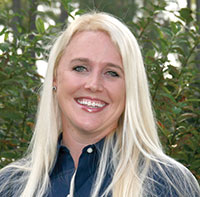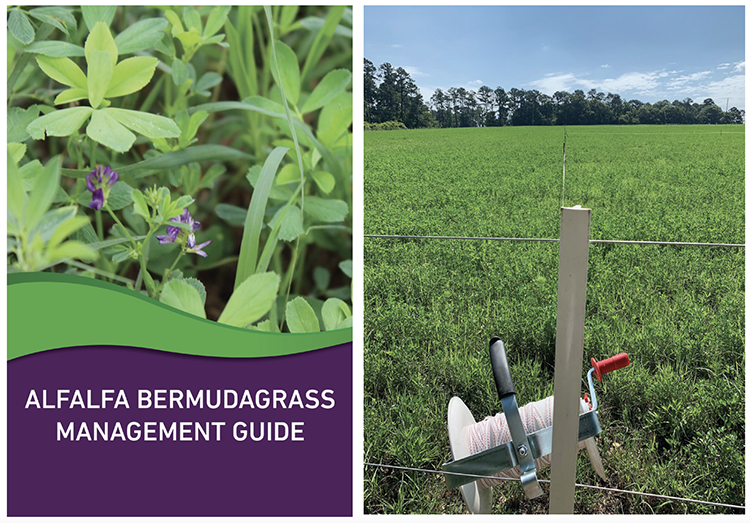Alfalfa-bermudagrass growers get new guide |
| By Hay and Forage Grower |
|
|
|
Hay & Forage Grower is featuring results of research projects funded through the Alfalfa Checkoff, officially named the U.S. Alfalfa Farmer Research Initiative, administered by National Alfalfa & Forage Alliance (NAFA). The checkoff program facilitates farmer-funded research.  Jennifer Tucker Funding: $20,500 The 6- by 9-inch publication, Alfalfa Bermudagrass Management Guide, is the brainchild of Jennifer Tucker, University of Georgia animal scientist, and Kim Mullenix, Auburn University extension beef systems specialist. Southern farmers newly integrating alfalfa into their bermudagrass systems were continually asking for a detailed “getting started” reference guide, Tucker said. Only one-page factsheets and articles on the dual-crop system existed. “We knew this alfalfa-bermudagrass mixture was going to work for several states, so we wrote a grant with the National Alfalfa & Forage Alliance to create a national publication,” Tucker said. “We saw a hole and decided to try and fill it.” In 2020, they hired Liliane Silva, then a post-doctorate scholar, to oversee the project. Silva is now Clemson University’s forage specialist, and South Carolina collaborates with Georgia and Alabama on current alfalfa-bermudagrass systems research. The 26-page publication begins with a definition of what the authors call the “Bermudagrass Belt.” Within this belt, an estimated 28 million acres of the warm-season perennial grass grows coast-to-coast, encompassing the entire southern part of the U.S. as well as much of the transition zone. Although the grass, which is used for both hay and pasture, is persistent, dependable, widely adapted, and high yielding, interseeding alfalfa can improve a field’s forage production and quality. Nitrogen-fixing alfalfa plants also can keep fertilizer costs manageable. Tucker and Mullenix developed research projects showing the benefits of the dual-crop system, and farmers have been slowly integrating the legume with bermudagrass. Most of the research and education has been in Alabama, Georgia, and Florida, but momentum is also building in South Carolina and Mississippi. “I have been here the last six to seven years and am now seeing more of an increase in adoption,” Tucker said. “More people are watching the work and saying, ‘Now I am ready to do it (integrate alfalfa).’ The other big factor coming into play are these astronomical prices of fertilizer inputs,” Tucker said. “While you do have to put fertilizer into the system, you don’t have to add nitrogen. Fertilizer prices are frustrating, but knowing we have potential alternatives is pretty exciting for us.” The guide offers growers the basics in planting and establishing alfalfa-bermudagrass mixtures, as well as information on soil and fertility recommendations, common nutrient deficiencies, and insect, disease, and weed control. The last chapter discusses the economics involved in incorporating alfalfa into a bermudagrass system. “We hit the high points with this,” Tucker said. Its small size lets farmers keep the guide where they need it. “We also added a fold-out management calendar that has tips for each month. For example, if I look at August, what do I need to be considering? Stockpiling? Scouting for diseases?” The guide is being handed out at conferences, cattlemen’s meetings, and extension training sessions. An online version can be downloaded at www.alfalfa.org. Print copies can also be ordered from the website. The researchers, using National Institute of Food and Agriculture (NIFA) funding, are now comparing different harvesting methods, including baleage, grazing, and what they call a dual-use cut-and-graze system. “We cut it a couple of times, we graze it a bit, let it rest, and then stockpile graze it because October, November, and December are when we need grazing acres,” Tucker explained. A follow-up NIFA grant will give the researchers a total of five years to examine the system, collect data, and look at nutrient cycling within the soil as well as within animals. They hope to measure the impact of alfalfa on the system, Tucker said. “We’re trying to answer more in-depth what the practice is really offering from a whole-system perspective while also developing best management practices for it.”  Project Results Developed a publication and a quick-resource pocket calendar on the management and production of alfalfa-bermudagrass mixtures. This article appeared in the March 2022 issue of Hay & Forage Grower on pages 22 and 23. Not a subscriber? Click to get the print magazine. |
